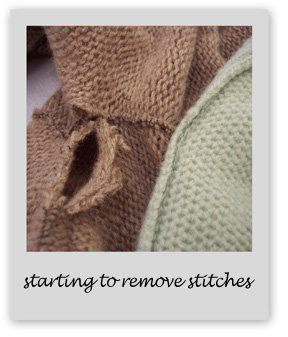When thrifting for wool sweaters there are clues I watch for:
• fiber content -- which for me is 100% wool
• labels that indicate it is hand knit or hand loomed
• a close look at the seams: a serged seam will indicate the possibility the item will contain only short pieces of yarn but a seam that has been chain stitched with matching yarn will indicate that the piece was knit back and forth with no break in the yarn. If there are no seams, even better, because the piece was knit in the round. The sweater pictured below has serged seams in the arms but the body was knit in the round.
Once the sweaters are home, it is time to clean them. Even though a thrift store requests a clean item, it does not mean it is truly clean. Most people do not want to go to the time and trouble of hand washing a nice wool sweater and will send it to a dry cleaner. I believe that the cleaning solutions the dry cleaners use are deposited in the wool and will remain there until the item is washed. I make a soaking solution of 1/4 cup Oxyclean and warm water in a 5 gallon bucket, stir well to dissolve the granules completely and then stuff the sweater into the water. Using a stick, I poke the sweater under the water and gently agitate it until it is completely wet. Then it sits overnight. I sometimes have to do this 2-3 times per sweater until the water rinses clear or dye is starting to release, then I know the wool is clean. Dry the sweater flat.
Now for the fun part, but if you have a cat make sure to lock it out of the room because, remember, you are working with yarn. Carefully pick apart the seams. I usually start by removing the arms, then the collar if there is one. Most sweaters are knit from the bottom up, so you will want to look at the neck edge or the shoulder edge of the arm for the end of the yarn. Sometimes you can pick apart the knot other times just snip it with a pair of scissors. Once you find the end start winding the yarn into a ball as you unravel the sweater. This sounds easier than it is, because wool yarn will stick to itself and be a bit cantankerous to unravel. Trust me, you do not want to unravel and then try to wind into a ball because you will end up with a snarled mass of kinky yarn. Here is the brown sweater again and you can see the bits of yarn at the edges of the arm seam. The arms and the upper portion of the body will end up being felted in the washing machine because I didn't want to have ALL those ends to weave in, ugh.
You can leave the crinkled yarn in the balls and just knit from there but I go one step further. Using a swift, I wind the yarn into hanks, but if you don't have a swift some ladder backed chairs work well or, in a time honored tradition, use an extra pair of hands. Once you have the yarn wound into hanks soak it in water, put it onto a hanger and put another hanger at the bottom. Yarn has a memory and as it dries the crinkles will, for the most part, be removed. Once the yarn is dry you can rewind it into balls or cakes and knit.
One of the sweaters from this batch was made from a hand spun yarn in New Zealand which resulted in 450gr of a DK weight yarn. Now to find a proper pattern to knit up.




Very cool! Since you say most of the wrinkles hang out, I guess it must knit up ok?
ReplyDeleteWow - that sounds like a lot of work, but I think I would enjoy the challenge. Be looking forward to seeing what you knit from your finds.
ReplyDeleteI saw quite a lot of that at Ravelry too and I would like to have a go at it.The only problem is that we don´t have that many thrift shops over here but I keep on looking. Thanks for the tips anyway! Take care.
ReplyDeleteVery industrious. What is the gram to yardage conversion? Once you pick a project, please keep us in blogland informed. ~ksp
ReplyDeleteAtta girl! I love the Thrift Shop finds! You found an amazing deal on the wool that did work out for you. Thanks for sharing the how to's and what to look for's. Happy knitting.
ReplyDeleteI have never known anyone that has done this. Super cool and green. Way to go.
ReplyDeleteGotta think you have quite a big of patience for it.